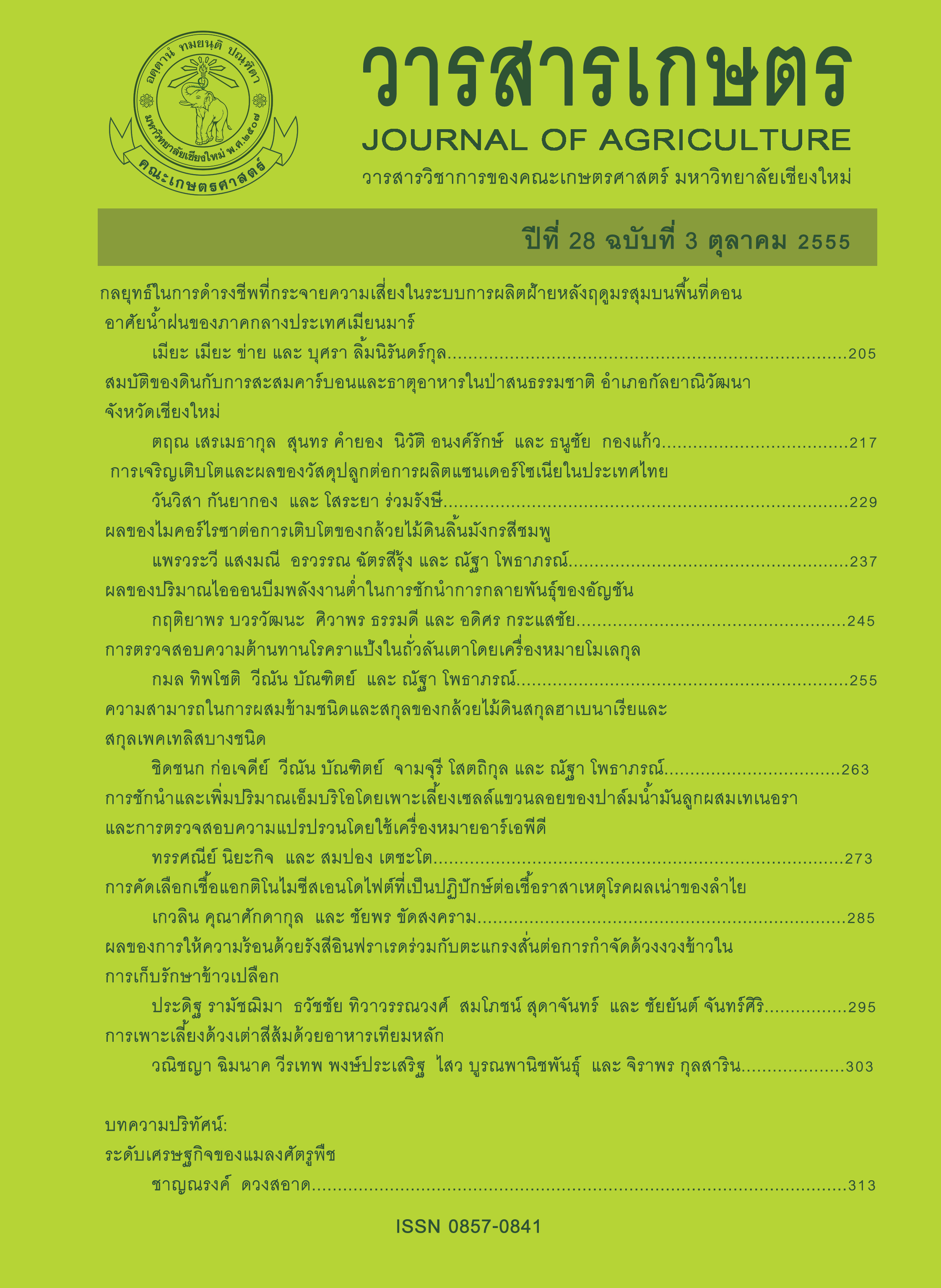การเพาะเลี้ยงด้วงเต่าสีส้มด้วยอาหารเทียมหลัก
Main Article Content
บทคัดย่อ
การศึกษาการเพาะเลี้ยงด้วงเต่าสีส้ม (Micraspis discolor (Fabricius))ในครั้งนี้ มีวัตถุประสงค์เพื่อค้นหาและคัดเลือกอาหารเทียมหลักที่เหมาะสมในการเพาะเลี้ยงเพิ่มปริมาณด้วงเต่าสีส้ม ภายในห้องปฏิบัติการ โดยเน้นการเพาะเลี้ยงด้วงเต่าสีส้มด้วยอาหารเทียมวุ้นจากวัตถุดิบหลัก 5 ชนิด คือ รังผึ้ง เกสรผึ้ง ตัวอ่อนผึ้ง ไข่แดง และวิตามินรวม ใช้แผนการทดลองแบบสุ่มสมบูรณ์ ทำ 30 ซ้ำ พบว่ามีเพียงอาหารเทียมวุ้นจากรังผึ้งและตัวอ่อนผึ้งเท่านั้นที่สามารถเพาะเลี้ยงด้วงเต่าสีส้มจนเป็นตัวเต็มวัยได้ โดยด้วงเต่าสีส้มที่เลี้ยงด้วยอาหารเทียมจากรังผึ้ง ตัวอ่อนผึ้ง ใช้ระยะเวลาการเจริญเติบโตจากระยะไข่ถึงตัวเต็มวัยเฉลี่ย คือ 36.25 และ 37.00 วันตามลำดับ ซึ่งยาวนานกว่าเมื่อเลี้ยงด้วยเพลี้ยอ่อนถั่วที่ใช้เวลาเฉลี่ย 13.47 วันเท่านั้น และผลการวิเคราะห์คุณลักษณะทางชีววิทยาด้วยตารางชีวิตแบบ partial ecological life table ของด้วงเต่าสีส้มที่เลี้ยงด้วยอาหารเทียมวุ้นจากรังผึ้ง มีอัตราการตายเกิดขึ้นในช่วงระยะไข่และตัวอ่อนระยะแรกสูงมาก ซึ่งสอดคล้องกับ survivorship curve แบบ Type III (P ≥ 0.05) ส่วนด้วงเต่าสีส้มที่เลี้ยงด้วยตัวอ่อนผึ้ง และเพลี้ยอ่อนถั่ว มีอัตราการตายน้อยมากในระยะแรกและเพิ่มสูงขึ้นในระยะเตรียมเข้าดักแด้และระยะดักแด้จึงสอดคล้องกับ survivorship curve แบบ Type I (P ≥ 0.05)
Article Details
เอกสารอ้างอิง
จิรพงศ์ ใจรินทร์. 2543. บทบาทของศัตรูธรรมชาติต่อการควบคุมเพลี้ยกระโดดสีน้ำตาล [Nilaparvata lugens (Stål)] ในนาข้าว. วารสารวิชาการเกษตร 18: 12-17.
วีรเทพ พงษ์ประเสริฐ ชุมพณ กันทะ วิภา หอมหวล สิริรัตน์ แสนยงค์ กมลวรรณ โรจน์สุนทรกิตติ และเกียรติศักดิ์ เกิดสุข. 2553. การบริหารโครงการและดำเนินโครงการวิจัยควบคุมศัตรูพืชโดยชีวินทรีย์แห่งชาติ: การควบคุมศัตรูพืชทางการเกษตรโดยชีววิธีของศูนย์ภาคเหนือตอนล่าง. รายงานการวิจัยฉบับสมบูรณ์. สำนักงานคณะกรรมการวิจัยแห่งชาติ, กรุงเทพฯ. 73 หน้า.
Agarwala, B. K. and M. S. Choudhuri. 1995. Use of alternative foods in the rearing of aphidophagous ladybeetle, Menochilus sexmaculatus Fabr. Entomon 20: 19-23.
Begum, M. A., M. Jahan, M. N. Bari, M. M. Hossain and N. Afsana. 2002. Potentiality of Micraspis discolor (F.) as a biocontrol agent of Nilaparvata lugens (Stal). J. Bio. Sci. 2(9): 630-632.
Chapman, R. F. 1998. The Insects: Structure and Function. 4thed. Cambridge University Press, Cambridge. 773 p.
Chen, Z. H., J. D. Qin and C. L. Shen. 1989. Effects of altering composition of artificial diets on the larval growth and development of Coccinella septempunctata. Acta Entomol. Sin. 32: 385-392.
Chowdhury, S. P., M. A. Ahad, M. R. Amin and M.S. Hasan. 2008. Biology of ladybird beetle Micraspis discolor (Fab.) (Coccinellidae: Coleoptera). Int. J. Sustain. Crop Prod. 3(3): 39-44.
De Clercq, P., M. Bonte, K. van Speybroeck, K. Bolckmans and K. Deforce. 2005. Development and reproduction of Adalia bipunctata (Coleoptera: Coccinellidae) on eggs of Ephestia kuehniella (Lepidoptera: Phycitidae) and pollen. Pest Manag. Sci. 61: 1129-1132.
Duffieded, S. J. 1995. Crop-specific differences in the seasonal abundance of four major predatory groups on sorghum and short-duration pigeon pea. Intl. Chickpea Pigeonpea Newsl. 2: 74-76.
Gautam, R. D., S. Chander, V. K. Sharma and R. Singh. 1995. Aphids infesting safflower, their predatory complex and effect on oil content. Ann. Plant Prot. Sci. 3(1): 27-30.
Kamal, N. Q. 1998. Brown planthopper (BPH), Nilaparvata lugens Stal situation in Bangladesh. A report of DAE-UNDP/FAO IPM Project, Khamarbari, Farmgate, Dhaka, Bangladesh.
Lucas, E., D. Coderre and C. Vincent. 1997. Voracity and feeding preferences of two aphidophagous coccinellids on Aphis citricola and Tetranychus urticae. Entomol. Exp. Appl. 85:151-159.
Mani, M. 1995. Studies of natural enemies of wax scale Drepanococcus chiton (Green) on ber and guava. Entomon 20(2): 55-58.
Nation, J. L. 2002. Insect Physiology and Biochemistry. CRC Press, Boca aton. 485 p.
Niijima, K., W. Abe and M. Matsuka. 1997. Development of low-cost and labor-saving artificial diet for mass production of an aphidophagous cocinellid, Harmonia axyridis (Pallas). Bull. Fac. Agric., Tamagawa Univ. 37: 63-74.
Rao, N. V., A. S. Reddy and K. T. Rao. 1989. Natural enemies of cotton whitefly, Bemisia tabaci Gennadius in relation to host population and weather factors. J. Biol. Control 3(1): 10-12.
Shepard, B. M. and H. R. Rapusas. 1989. Life cycle of Micraspis sp. on brown planthopper (BPH) and rice pollen. Int. Rice Res. Newsl. 14: 40.
Silva, R. B., J. C. Zanuncio, J. E. Serrao, E. R. Lima, M. L. C. Figueirdo and I. Cruz. 2009. Suitability of different artificial diets for development and survival of stages of the predaceous ladybird beetle Eriopis connexa. Phytoparasitica 37: 115-123.
Smirnoff, W. A. 1958. An artificial diet for rearing coccinellid beetles. Can. Entomol. 90: 563-565.


